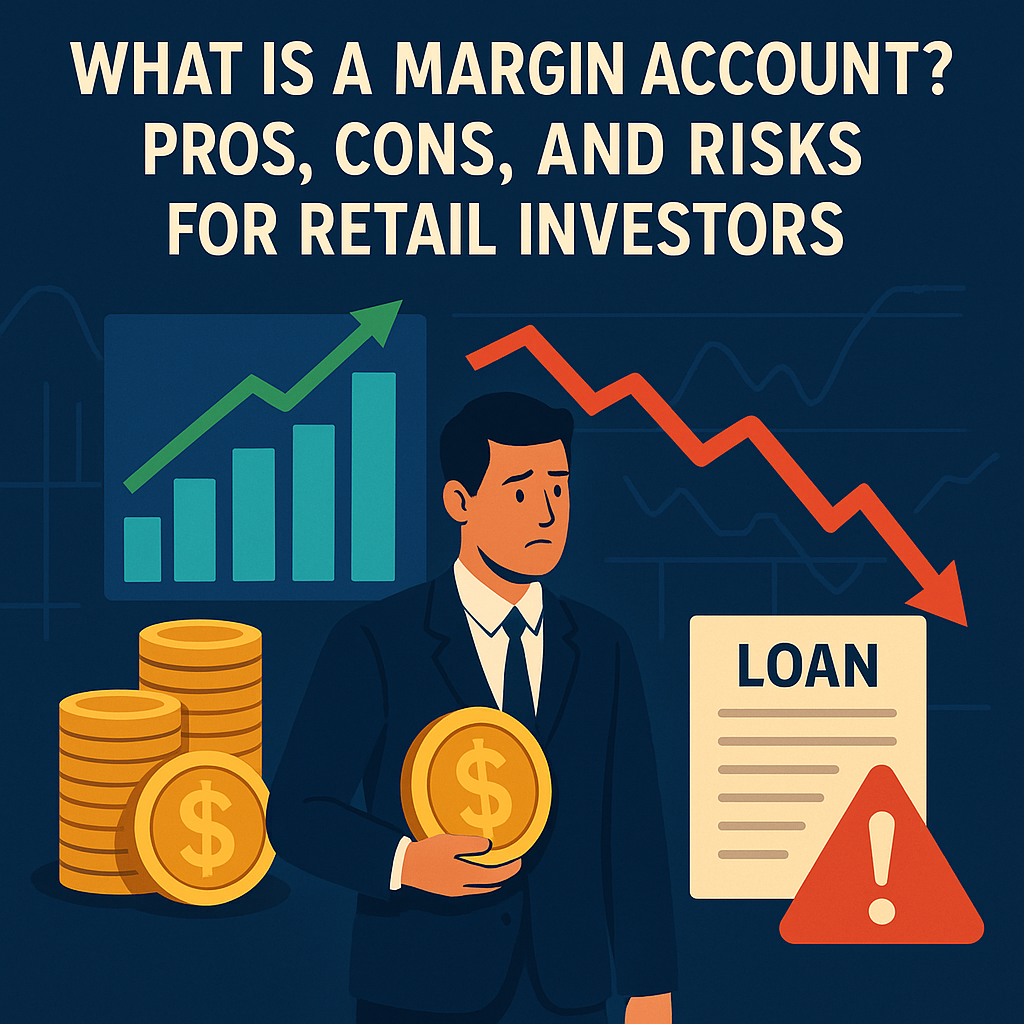For retail investors looking to amplify their trading potential, a margin account can appear to be an attractive tool. It offers the ability to borrow funds from a brokerage firm to purchase securities, potentially leading to magnified gains. However, this power comes with significant complexities and inherent risks that every investor must thoroughly understand before leveraging margin. This comprehensive guide delves into the intricacies of margin accounts, exploring their mechanics, advantages, disadvantages, and the crucial risks involved for retail investors.
Understanding the Mechanics of a Margin Account
At its core, a margin account allows investors to leverage borrowed money from their brokerage to increase their purchasing power. Instead of paying the full price for securities, investors can put down a percentage of the cost, known as the initial margin, and borrow the remaining amount from the broker. The securities purchased act as collateral for the loan.
Key Concepts:
- Marginable Securities: Not all securities are eligible for margin trading. Typically, well-established stocks listed on major exchanges, certain bonds, and some exchange-traded funds (ETFs) are marginable. The brokerage firm determines which securities qualify.
- Initial Margin Requirement: This is the percentage of the purchase price an investor must deposit from their own funds. Regulatory bodies like the Financial Industry Regulatory Authority (FINRA) in the United States set minimum initial margin requirements for certain securities (currently 50% for most stocks). Brokerage firms can also set their own, often higher, requirements.
- Maintenance Margin Requirement: This is the minimum equity an investor must maintain in their margin account relative to the total market value of the securities. If the equity falls below this level, the investor faces a margin call. FINRA’s minimum maintenance margin is typically 25%, but brokerages can set higher thresholds.
- Margin Call: A margin call occurs when the equity in an investor’s margin account drops below the maintenance margin requirement. The brokerage firm demands that the investor deposit additional funds or sell securities to bring the account back up to the required level. Failure to meet a margin call can result in the brokerage liquidating the investor’s positions without prior consent.
- Interest on Margin Loan: Borrowed funds through a margin account are not free. Brokerage firms charge interest on the outstanding margin loan balance. The interest rate can vary depending on factors such as the loan amount and prevailing market interest rates. This interest expense reduces the investor’s overall returns.
- Equity: In a margin account, equity represents the portion of the securities’ value that the investor actually owns. It is calculated as the total market value of securities minus the amount of the margin loan.
Example:
Let’s say an investor wants to purchase $10,000 worth of a marginable stock with an initial margin requirement of 50%.
- Initial Investment: The investor needs to deposit $5,000 (50% of $10,000) from their own funds.
- Margin Loan: The brokerage firm lends the remaining $5,000.
- Total Investment: The investor now controls $10,000 worth of stock.
If the stock price increases by 10%, the total value becomes $11,000. Selling the stock would result in $11,000, from which the $5,000 loan is repaid, leaving the investor with $6,000 (excluding interest and potential transaction costs). This represents a 20% return on their initial $5,000 investment, demonstrating the potential for amplified gains.
However, if the stock price decreases by 10%, the total value becomes $9,000. Selling the stock would result in $9,000, from which the $5,000 loan is repaid, leaving the investor with $4,000. This represents a 20% loss on their initial $5,000 investment, highlighting the amplified losses associated with margin.
Pros of Using a Margin Account
While the risks are significant, margin accounts can offer several potential benefits for sophisticated retail investors:
1. Amplified Potential Returns
As illustrated in the example above, margin allows investors to control a larger position than their initial capital would otherwise permit. This leverage can magnify profits when the value of the underlying securities increases. For investors with a strong conviction in a particular investment, margin can potentially accelerate their returns.
2. Increased Purchasing Power
Margin effectively increases the amount of capital an investor has available for trading. This allows them to take advantage of more investment opportunities or build a more diversified portfolio than they could with their cash alone.
3. Flexibility in Trading Strategies
Margin can be a valuable tool for implementing certain trading strategies, such as short selling. Short selling involves borrowing shares and selling them with the hope of buying them back at a lower price later. Margin accounts are typically required for short selling to ensure the investor can cover potential losses if the stock price rises.
4. Avoiding Liquidation of Other Holdings
In situations where an investor wants to take advantage of a time-sensitive investment opportunity but doesn’t have immediate cash available, margin can provide the necessary funds without requiring them to liquidate other long-term holdings. This can help avoid potential tax implications or the disruption of a well-structured investment strategy.
5. Potential for Lower Transaction Costs (in some cases)
For active traders who execute frequent trades, maintaining a margin account might, in some cases, lead to lower overall transaction costs compared to constantly transferring funds for each trade. However, the interest paid on the margin loan needs to be carefully considered in this calculation.
Cons and Risks of Using a Margin Account
Despite the potential benefits, the drawbacks and risks associated with margin accounts are substantial and should not be underestimated by retail investors:
1. Amplified Potential Losses
Just as margin can magnify gains, it can also significantly amplify losses. If the value of the securities purchased on margin declines, the investor can lose not only their initial investment but also the borrowed funds. In percentage terms, losses can exceed the initial capital outlay.
2. The Risk of Margin Calls
A margin call can be a stressful and financially damaging event. If the equity in the account falls below the maintenance margin requirement, the investor is obligated to deposit additional funds or sell securities quickly, often at unfavorable prices, to meet the call. Failure to do so can lead to the brokerage liquidating positions without the investor’s consent, potentially resulting in significant losses.
3. Interest Expenses
The interest charged on the margin loan can erode potential profits and even contribute to losses. The longer the margin loan is outstanding, the more interest accrues. Fluctuations in interest rates can also impact the cost of borrowing.
4. Forced Liquidation
Brokerage firms have the right to liquidate securities in a margin account without prior notice or the investor’s consent if the account falls below the maintenance margin. The brokerage is not obligated to wait for a more favorable market price, and the investor may be forced to sell at a loss.
5. The Potential for Debt
Using margin essentially means taking on debt to invest. If the investments perform poorly, the investor could end up owing the brokerage more money than their initial investment, putting them in a precarious financial situation.
6. Complexity and Lack of Understanding
Margin trading involves complex mechanics and calculations. 1 Retail investors who do not fully understand the intricacies of margin requirements, margin calls, and interest charges are particularly vulnerable to making costly mistakes.
7. Emotional Decision-Making
The leverage provided by margin can exacerbate emotional decision-making. The pressure of potentially larger gains or the fear of amplified losses can lead to impulsive and irrational trading behavior.
Risks Specifically for Retail Investors
Retail investors, particularly those new to the market or with limited capital, face heightened risks when using margin accounts:
- Limited Financial Cushion: Retail investors often have less capital reserves to absorb potential losses from margin trading or to meet margin calls. This can lead to more severe financial consequences.
- Lack of Sophistication: Compared to institutional investors, retail investors may have less experience and understanding of complex trading strategies and risk management techniques necessary for successful margin trading.
- Susceptibility to Market Volatility: Retail investors might be more prone to emotional responses during periods of market volatility, potentially leading to poor decisions when managing their margin positions.
- Higher Proportion of Debt: For retail investors, the borrowed funds in a margin account might represent a larger proportion of their overall financial resources, making them more vulnerable to the negative impacts of leverage.
Regulatory Considerations and Investor Protection
Regulatory bodies like FINRA in the United States and the Financial Conduct Authority (FCA) in the United Kingdom have implemented rules and regulations to protect retail investors engaging in margin trading. These include:
- Minimum Margin Requirements: Setting minimum initial and maintenance margin levels to ensure investors have a certain amount of their own capital at risk.
- Disclosure Requirements: Brokerage firms are required to provide clear and comprehensive information about the risks associated with margin trading before an investor opens a margin account. This includes a margin disclosure statement outlining the terms and conditions.
- Suitability Assessments: Brokerages have a responsibility to ensure that margin trading is suitable for a particular investor based on their financial situation, investment experience, and risk tolerance.
Reference Link:
For further information on margin accounts and investor protection, you can refer to the Financial Industry Regulatory Authority (FINRA) website: https://www.finra.org/investors/learn-to-invest/advanced-investing/understanding-margin-accounts
Disclaimer:
This article provides general information about margin accounts and should not be considered financial advice. Margin trading involves significant risks and is not suitable for all investors. Before engaging in margin trading, you should carefully consider your investment objectives, risk tolerance, and financial situation. You may lose more than your initial investment. It is recommended to consult with a qualified financial advisor before making any investment decisions.
Conclusion: Proceed with Extreme Caution
A margin account can be a powerful tool, offering the potential for amplified returns and increased trading flexibility. However, this power comes with equally significant risks, including the potential for magnified losses, margin calls, forced liquidation, and the burden of interest expenses. For retail investors, who may have less capital and experience, these risks are particularly pronounced.
Before even considering opening a margin account, retail investors must conduct thorough research, fully understand the mechanics and risks involved, and honestly assess their risk tolerance and financial capacity to handle potential losses. It is crucial to start with a strong understanding of the underlying investments and to have a well-defined trading strategy with strict risk management controls in place.
Disclaimer
The information provided in this article is for educational purposes only and does not constitute financial advice. Trading involves significant risks, including the potential loss of capital. Always conduct your own research and consult a qualified financial advisor before making trading decisions. The author and publisher are not responsible for any losses incurred from using the information in this article.








